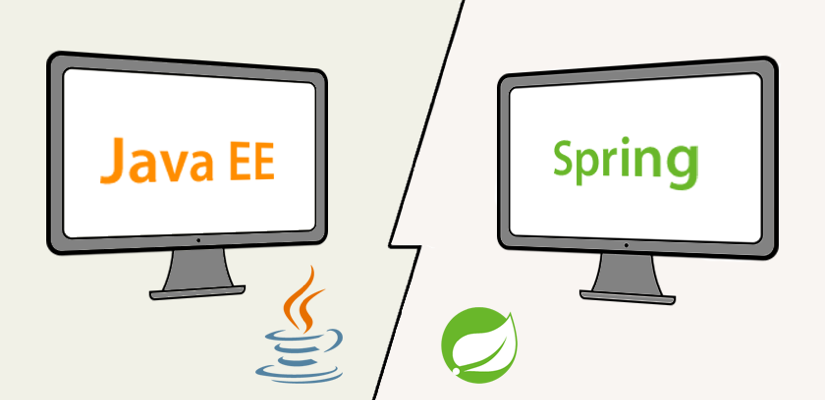
Java EE Vs Spring Framework: All That You Need To Know In 2023
The Java community always had a debate over Spring and Java EE with never-ending opinions from nerds and evangelists who support either framework. However, there are certain aspects of these frameworks that every developer, team, and project must consider in varied situations. In this blog, we shall break down the differences between these two popular Java frameworks – Java EE Vs Spring.
Spring Overview
Spring refers to an application development framework for Java EE. It is an open-source Java platform that provides support for developing robust and large-scale Java applications. Also, the Spring framework offers a wide-array of extensions effective for building all the large-scale applications above the Java EE platform.
It is a lightweight framework that enables developers to develop enterprise applications in Java using Plain Old Java Object (POJO). However, the Spring framework does not have any specific programming model. It is a huge community of Java developers working and contributing towards more extensions. Together they are improving existing features offered by the Spring framework.
Major benefits of Spring Framework
If you are a Java developer looking for enterprise application in Java and wondering which framework will cater to your development demands, get the insights first. Here are the major benefits of choosing the Spring framework:
- It allows using plain old Java objects, which means developers no longer require an enterprise container like an application server.
- It provides a high level of modularity when you hire Java developers
- It offers a well-developed web framework for an easy-to-build experience
- It helps efficiently organize middle-tier objects
- Its codes are easy to make test cases for numerous testing processes.
Major drawbacks of Spring Framework
- It is relatively complex to build on this framework due to a lack of clear focus
- If you are a beginner, learning the Spring framework might get challenging
- To start with Spring, you need some knowledge of XML
- The Spring documentation lacks clear guidelines on numerous topics
- It takes a lot of time and effort to configure the initial stages of this framework
Key differences between Java EE vs Spring
Java EE vs Spring debate is based on the comparison of various specific features. Both these platforms are popular among Java developers but they both have some prominent differences in terms of features, services, and cost. Let’s discuss some of the major differences between Java EE vs Spring:
Architectural differences
Java EE operates on a three-tier architecture. The first is the presentation tier which contains the user interface and focuses on delivering a smooth and stable experience. The second is the application tier which contains the main business logic of the application, and the third contains the data-tier, which comprises the database and other data requirements.
Spring, on the other hand, is based on a layered architecture that includes varied modules. Each module delivers different features for the application and is built on top of its core containers.
Language support
Java EE uses a high-level object-oriented programming language and is responsible to check each described feature of the programming language. On the other hand, Spring does not have any individual programming language. When you hire Java developers, they can either choose Java or Kotlin in Spring.
Structures
Java EE helps develop either web-based or non-web-based structures, whereas, Spring offers numerous structures for your application including Microservices, cloud, serverless event driver, web applications, and more.
Performance and speed
Speed is something that is always brought up in Java EE and Spring frameworks. However, when it comes to speed, Java EE is the winner, because Spring is comparatively slower than Java EE in terms of performance and usability.
Project cost
Cost is one of the primary differences between Java EE vs Spring. The framework comes with an Oracle-based license, whereas Spring has an open-source license, which is entirely free to use.
Standardization
Java EE is a Sun/Oracle standard/specification, which incorporates Object-Relational Mapping, Security, Web Applications, database availability, exchanges, and more. On the other hand, Spring is a framework for Java EE itself. It is a structure that offers a wide array of functions on the Java EE, but in its frame.
Conclusion
Java EE vs Spring debate is not easy to conclude topic because both frameworks offer unique features. Java EE is primarily intended for organizations and enterprises that require an expensive, adaptable, and disseminated framework that helps to build large-scale applications.
Regardless of these prominent offerings, the Spring framework has gained a lot of competitors to Java EE. It is easier to use and provides a stable environment for web advancements whereas, Java EE lacks these offerings.
Although Java EE has a large user base in organizations and enterprises, Spring ranks as the developer’s first choice.
Are you looking for Java app development services from a professional Java development company in India? We can help. Java India offers world-class software solutions to businesses of all shapes and sizes.
FAQs
Which version of Java is the best?
Java 11 – where 48% of the applications are built on Java 11, and Java 8 is a close second covering 46.5% of applications using this version in production.
Which tech giants use Java?
More than 10283 companies prefer Java over other programming languages and frameworks. Some of these brands include Uber, Airbnb, Google, Netflix, Instagram, Spotify, Amazon, and more.
Which Java Edition is the best?
The standard edition of Java Edition is the core Java programming platform. It includes all the core libraries and APIs that every Java programmer needs to learn and implement.

